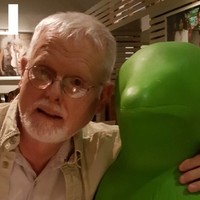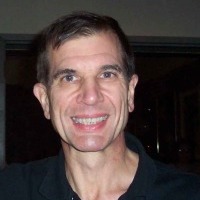Papers by Christopher Buneo
2022 44th Annual International Conference of the IEEE Engineering in Medicine & Biology Society (EMBC)

2021 43rd Annual International Conference of the IEEE Engineering in Medicine & Biology Society (EMBC), 2021
The acquisition of neurophysiological data during awake, behaving animal experiments typically in... more The acquisition of neurophysiological data during awake, behaving animal experiments typically involves experimental sessions lasting several days to weeks. Therefore, it is important to understand natural fluctuations in behavioral performance over such periods. Here we quantified patterns of movement variability for reaches performed by two monkeys across five daily experimental sessions. The monkeys were trained to move in an immersive virtual reality (VR) environment that was designed to resemble the experimental room. Visual feedback of the limb was provided using VR avatar arms that were controlled through a reflective marker-based motion capture system. Additionally, tactile cues were provided in the form of physical reach targets. Spatial variability was characterized at early (peak acceleration) and late (movement endpoint) kinematic landmarks. We found that the magnitude of variability was generally larger at peak acceleration than at the endpoint but was relatively consistent across days and within animals. The spatial characteristics of variability were also generally highly consistent at peak acceleration both within and between animals but were noticeably less so at the endpoint. The results highlight the benefits of using early kinematic landmarks such as peak acceleration for quantifying movement variability in reaching studies involving animals.
Three-Dimensional Kinematics of Eye, Head and Limb Movements, 2020
... We could offer no kinematic explanation for the postural variation observed in our study (eg,... more ... We could offer no kinematic explanation for the postural variation observed in our study (eg, it did not tend to minimize the total joint excursion). ... Soechting, JF and Lacquaniti, F.(1981) Invariant characteristics of a pointing movement in man. ... Wrist motion is piece-wise planar. ...
The Journal of Neuroscience, 1997

Reaching movements are subject to noise arising during the sensing, planning and execution phases... more Reaching movements are subject to noise arising during the sensing, planning and execution phases of movement production, which contributes to movement variability. When vision of the moving hand is available, reaching variability appears to be strongly influenced by noise occurring during the specification and/or online updating of movement plans in visual coordinates. In contrast, when vision of the hand is unavailable, variability appears more dependent upon hand movement direction, suggesting a greater influence of execution noise. Given that execution noise acts in part at the muscular level, we hypothesized that reaching variability should depend not only on movement direction but initial arm posture as well. Moreover, given that the effects of execution noise are more apparent when movements are performed without vision of the hand, we reasoned that postural effects would be more evident when visual feedback was withheld. To test these hypotheses, subjects planned memory-guid...

Archives Italiennes De Biologie, Jan 7, 2002
We have adjusted and validated models of the lines of action of six human shoulder muscles. Compa... more We have adjusted and validated models of the lines of action of six human shoulder muscles. Compared to other models of the shoulder mechanism (e.g., 9, 11, 17, 24) ours is greatly simplified in that the scapula and its many muscles are largely neglected, and the action of each of six broad muscles is summarized by a single line segment. The close correspondence between measured and predicted moment direction over a wide range of postures suggests that this latter simplification was reasonable. We found that assignment of two via points (one fixed to the origin and one fixed to the insertion) was adequate to represent the measured actions, and our sensitivity analysis highlights the importance of via point placement. Because our model predicts the action of each muscle over a very large range of arm postures, it should be useful for future investigations of the control of muscle forces.

Novartis Foundation Symposia, 2007
The posterior parietal cortex (PPC) has long been considered a sensory area specialized for spati... more The posterior parietal cortex (PPC) has long been considered a sensory area specialized for spatial awareness and the directing of attention. However, a new, far reaching concept is now emerging that this area is involved in integrating sensory information for the purpose of planning action. Moreover, experiments by our group and others over the last two decades indicate that PPC is in fact anatomically organized with respect to action. PPC also is an 'association' cortex which must combine different sensory modalities which are coded in different coordinate frames. We have found, at least for two different cortical areas within PPC, that different sensory signals are brought into a common coordinate frame. This coordinate frame codes locations with respect to the eye, but also gain modulates the activity by eye and body position signals. An interesting feature of this coordinate representation at the population level is that it codes concurrently target locations in multiple coordinate frames (eye, head, body and world). Depending on how this population of neurons is sampled, different coordinate transformations can be accomplished by the same population of neurons.
Encyclopedia of Neuroscience, 2009
Advances in neurology, 2003
[noabstract

Conference proceedings : ... Annual International Conference of the IEEE Engineering in Medicine and Biology Society. IEEE Engineering in Medicine and Biology Society. Annual Conference, 2009
Numerical simulations were used to explore the consequences of a spatially non-uniform sense of h... more Numerical simulations were used to explore the consequences of a spatially non-uniform sense of hand position on arm movements in the horizontal plane. Isotropic or anisotropic position errors were introduced into several starting hand positions and the resulting errors in movement direction were quantified. Two separate simulations were performed. In one simulation planned movement directions were defined relative to the starting position of the hand. Movement errors generated in this simulation resulted from a failure to compensate for differing initial conditions. In a second simulation planned movement directions were defined by the vector joining the sensed starting position with a fixed target position. Movement errors in this simulation resulted from both uncompensated changes in initial conditions as well as errors in movement planning. In both simulations, directional error variability generally increased for starting positions closer to the body. These effects were most pr...
Sensory Cue Integration, 2011

Frontiers in Integrative Neuroscience, 2013
The posterior parietal cortex (PPC) is thought to play an important role in the planning of visua... more The posterior parietal cortex (PPC) is thought to play an important role in the planning of visually-guided reaching movements. However, the relative roles of the various subdivisions of the PPC in this function are still poorly understood. For example, studies of dorsal area 5 point to a representation of reaches in both extrinsic (endpoint) and intrinsic (joint or muscle) coordinates, as evidenced by partial changes in preferred directions and positional discharge with changes in arm posture. In contrast, recent findings suggest that the adjacent medial intraparietal area (MIP) is involved in more abstract representations, e.g., encoding reach target in visual coordinates. Such a representation is suitable for planning reach trajectories involving shortest distance paths to targets straight ahead. However, it is currently unclear how MIP contributes to the planning of other types of trajectories, including those with various degrees of curvature. Such curved trajectories recruit different joint excursions and might help us address whether their representation in the PPC is purely in extrinsic coordinates or in intrinsic ones as well. Here we investigated the role of the PPC in these processes during an obstacle avoidance task for which the animals had not been explicitly trained. We found that PPC planning activity was predictive of both the spatial and temporal aspects of upcoming trajectories. The same PPC neurons predicted the upcoming trajectory in both endpoint and joint coordinates. The predictive power of these neurons remained stable and accurate despite concomitant motor learning across task conditions. These findings suggest the role of the PPC can be extended from specifying abstract movement goals to expressing these plans as corresponding trajectories in both endpoint and joint coordinates. Thus, the PPC appears to contribute to reach planning and approach-avoidance arm motions at multiple levels of representation.

Frontiers in Neuroscience
Reaching movements are subject to noise arising during the sensing, planning and execution phases... more Reaching movements are subject to noise arising during the sensing, planning and execution phases of movement production, which contributes to movement variability. When vision of the moving hand is available, reach endpoint variability appears to be strongly influenced by internal noise associated with the specification and/or online updating of movement plans in visual coordinates. In contrast, without hand vision, endpoint variability appears more dependent upon movement direction, suggesting a greater influence of execution noise. Given that execution noise acts in part at the muscular level, we hypothesized that reaching variability should depend not only on movement direction but initial arm posture as well. Moreover, given that the effects of execution noise are more apparent when hand vision is unavailable, we reasoned that postural effects would be more evident when visual feedback was withheld. To test these hypotheses, participants planned memory-guided reaching movements...

This data was collected from the Parietal Cortex of two male rhesus macaques (macaca mulatta) usi... more This data was collected from the Parietal Cortex of two male rhesus macaques (macaca mulatta) using single microelectrodes. For each recording session, single-cell recordings (N=343; 219 from monkey X and 124 from monkey B) were made in the superficial cortex of the SPL (area 5), as judged by recording depth and similarity to previous recordings made in this area with standard neurophysiological techniques. Activity was recorded extracellularly with varnish-coated tungsten microelectrodes (~1- to 2-MΩ impedance at 1 kHz). Single action potentials (spikes) were isolated from the amplified and filtered (600–6,000 Hz) signal via a time-amplitude window discriminator (Plexon). Spike times were sampled at 2.5 kHz. Within a virtual reality environment where visual feedback of the limb could be manipulated, animals performed a reaction-time task involving combined eye and arm movements from a single (central) starting position to one of eight peripheral targets. Results from the experiment...

2020 42nd Annual International Conference of the IEEE Engineering in Medicine & Biology Society (EMBC), 2020
Multisensory integration is the process by which information from different sensory modalities is... more Multisensory integration is the process by which information from different sensory modalities is integrated by the nervous system. Understanding this process is important not only from a basic science perspective but also for translational reasons, e.g. for the development of closed-loop neural prosthetic systems. Here we describe a versatile virtual reality platform which can be used to study the neural mechanisms of multisensory integration for the upper limb and could potentially be incorporated into systems for training of robust neural prosthetic control. The platform involves the interaction of multiple computers and programs and allows for selection of different avatar arms and for modification of a selected arm’s visual properties. The system was tested with two non-human primates (NHP) that were trained to reach to multiple targets on a tabletop. Reliability of arm visual feedback was altered by applying different levels of blurring to the arm. In addition, tactile feedbac...

2020 42nd Annual International Conference of the IEEE Engineering in Medicine & Biology Society (EMBC), 2020
Electrical stimulation of the vagus nerve has been shown to enhance cortical plasticity and may b... more Electrical stimulation of the vagus nerve has been shown to enhance cortical plasticity and may benefit upper extremity rehabilitation following stroke. As an initial step towards assessing the potential of other craniocervical nerves as neuromodulation targets during rehabilitation, we explored the ability of non-invasive stimulation of cervical spine afferents, paired with a proprioceptive discrimination task, to improve sensory function in neurologically intact human subjects. On each trial, subjects’ arms were moved by a robot from a test position, along a random path, to a judgment position located 1-4 cm away. Subjects responded ‘same’ if the judgment position was the same as the test or ‘different’ if it was not. These responses were used to compute proprioceptive sensitivity and bias. Three groups of 20 subjects received transcutaneous electric nerve stimulation to the C3/C4 cervical spine at one of three frequencies (30 Hz, 300 Hz, 3 kHz) for 10 minutes prior to task perfor...

Although multisensory integration is crucial for sensorimotor function, it is still unclear how s... more Although multisensory integration is crucial for sensorimotor function, it is still unclear how sensory cues provided by the visual and proprioceptive systems are combined in the brain during motor behaviors. Here we characterized the effects of multisensory interactions on local field potential (LFP) activity obtained from the superior parietal lobule (SPL) as non-human primates performed an arm position maintenance task with either unimodal (proprioceptive) or bimodal (visual-proprioceptive) sensory feedback. Based on previous analyses of spiking activity, and observations that LFP and spikes are highly correlated in some cortical areas, we hypothesized that evoked LFP responses would be tuned to arm location but would be suppressed on bimodal trials, relative to unimodal trials. We also expected to see a substantial number of recording sites with enhanced beta band spectral power for only one set of feedback conditions, as was previously observed for spiking activity. We found th...











Uploads
Papers by Christopher Buneo